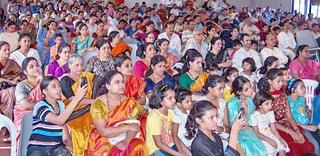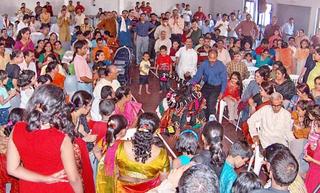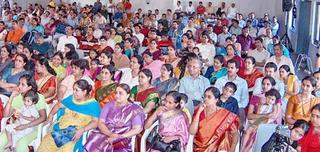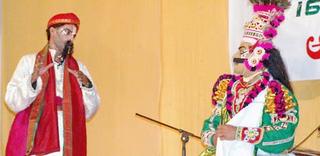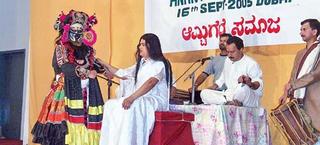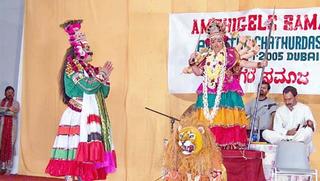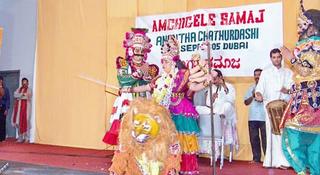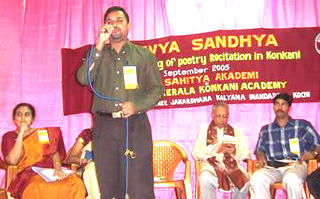Those who are addicted to Mysore Akashavani can never forget Dr. Jyotsna Kamath's voice. Not that she was a vocalist, or a musician. She was Akshavani's Director for quite some years and had become a part of Mysore. She was the voice behind voices, a publicist of publicists. She was a very good administrator, one who could draw the best out of every member of her organisation, and made the radio station throb in all directions. Her head was a beehive of activity, always engaged in some innovation or the other.
The station was woefully lacking even in basic facilities, having no infrastructure. The once most dynamic broadcasting station was reduced to the state of disrepute because our State administrators who wanted to reduce the royal city of Mysore to the status of a semi-urban centre, shifted the radio station to Bangalore and Mysore's voice was throttled.
The beautiful building specially designed and got constructed by the visionary ruler of Mysore was converted into a godown.
A clever ploy
The people of Mysore are good talkers and not achievers. Though some of the zealous officers of the All India Radio came forward to secure again for Mysore a powerful station, our so-called leaders never raised their voice against the injustice perpetrated against the city. At last one of the engineers, who was a lover of Mysore, devised a clever ploy and got a station. But it was so weak that its voice could hardly be heard beyond the boundaries of the then city.
Any way, something was better than nothing. The repeated requests by lesser men who were more concerned about it, were of no avail. The higher authorities were frequently threatening that even the weak station would be closed down!
The building which was being used as a godown, was poorly equipped. The doors were rattling. Those who participated in the programmes had to press the door close with one hand and hold the script with the other hand!
Some of the Directors (they were called Assistant Directors!) tried hard to improve the situation and were partially successful. The apathy of the authorities came in the way. It was feared that the station might be closed any day.
One of the directors of the station was Dr. Jyotsna Kamath. She was aware of all the hurdles against which she had to struggle, but never minded them. Not once did she mention them. Kriyasiddhi (achievement) comes to those who have sattva (ability). They do not grumble about the non-availability of facilities (upakarana).
Dr. Jyotsna Kamath (1937) belongs to Kumta town of Uttara Kannada district. Her father was Ganesha Rao and mother Sharadabai. Ganesha Rao was a Post Master and Jyotsna had her early education at the village schools. Her father was a lover of books and possessed a rich library. Jyotsna pored over the books with great avidity. She found great pleasure like Robert Southey, in the company of great authors who were not living. When she got the BA degree from the Kumta college, she was brimming with great thoughts imbibed from the best books that were available then. She was a student of Dr. Krishna Murthy, a great Sanskrit scholar. She was interested in history also. She studied for one year and got a diploma in education. This helped her become a high-school teacher.
Academic achievements
She had an insatiable thirst for knowledge and this led her to the MA Degree in history. The professors who impressed her were Dr. B.A. Saletore, Dr. P.B. Desai and Dr. G.S. Dixit. She took up research which continued even after she was well in the service of the All India Radio and was married and had a child. She got the Ph.D. degree for her thesis on 'The social life in medieval Karnataka,' which was later published by a Delhi publisher.
She took the UPSC examination and was selected and appointed as the Programme Executive of Akashavani. She took her profession so seriously that she never hesitated to go to any place to which she was transferred. It was a blessing in disguise. She acquired a wealth of experience and got an insight into the ways of living, culture and languages of the people of the different regions. In addition to Kannada and English, she knew Konkani, Hindi, Marathi, Bengali and Sanskrit.
When Dr. Jyotsna Kamath was the director of Akashavani centres in Mysore and Bangalore, she introduced many novel programmes, tried her best to reach out to the people and chalked out novel pro-grammes which were both entertaining and instructive. Folk arts, classical music, dramas, talks and discussions were encouraged and were made attractive.
Innovative methods
She enlisted the co-operation of all sections of the people and drew the best out of them. The running commentary of the famous Dasara procession reached the heights of excellence, thanks to her zeal and enthusiasm and innovative methods. With the skeleton staff and poor equipment, she produced excellent results. She arranged a series of talks by eminent persons on important topics and held Kavi Goshtis (recitals of poems by the authors).
A collection of poems read at the time of Ugadi (New Year) and a series of talks on the relevance of Gandhi today were brought out in the form of collections. Such work continued in Bangalore also when she became the Station Director there. The papers presented at the workshop on 'writing for the radio' were also published in book form (Banuli Baravanige).
Dr. Jyotsna Kamath is a writer also. 'The charms of family life,' 'See how we are' and a few other books are to her credit. She evinced much interest in education and her book on the educational tradition of Karnataka (in Kannada) has won the Academy Award as the best book on the subject. She has written numerous articles on diverse subjects. Her husband Dr. Krishnananda Kamath was a natural scientist, photographer, artist and writer. Theirs was a happy and contented family with one son.



